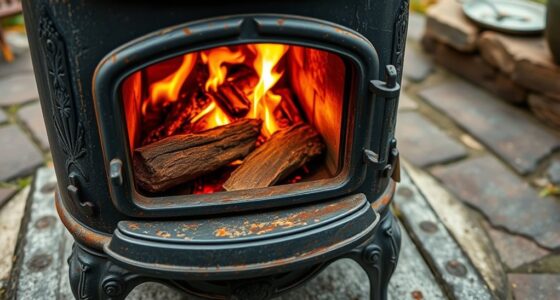To guarantee efficient burning, you should season your firewood for about six to twelve months, depending on the type of wood. Hardwoods like oak or hickory need closer to a year, while softer woods like pine or cedar may only take a few months. Properly seasoned wood has around 20% moisture content, ignites easily, and produces less smoke. Keep in mind, good storage methods aid in this process—continue exploring to learn more.
Key Takeaways
- Most hardwoods require 6 to 12 months of seasoning before burning effectively.
- Softer woods like pine or cedar typically season faster, often within 6 months.
- Proper seasoning reduces moisture content to around 20%, improving burn quality.
- Use a moisture meter to confirm wood has reached optimal dryness before use.
- Signs of seasoned wood include light weight, low smoke, and steady ignition.

If you want your wood to burn efficiently and produce maximum heat, it’s essential to let it season properly before lighting a fire. Proper seasoning reduces the moisture content in the wood, which is vital for a clean, hot burn. Freshly cut wood, often called green wood, contains high levels of moisture—sometimes up to 50% or more—which makes it harder to ignite and causes inefficient combustion. When moisture is trapped inside the wood, it leads to excessive smoke, creosote buildup in your chimney, and less heat output. To avoid these issues, you need to understand the importance of wood storage techniques that promote proper seasoning.
The key to effective wood storage is ensuring good airflow and keeping the wood dry. Stack your wood off the ground on a pallet or a raised platform to prevent ground moisture from seeping in. Leave enough space between logs to allow air to circulate freely around each piece. Cover the top of your stack with a waterproof tarp or a metal roof, but leave the sides exposed to promote ventilation. This prevents rain from soaking the wood while enabling moisture to escape, helping the wood dry evenly. Proper stacking and covering are essential wood storage techniques that influence how quickly your wood seasons and how low its moisture content remains during storage.
The ideal moisture content for burning wood is around 20%, which typically requires seasoning for at least six to twelve months, depending on the type of wood and climate conditions. Hardwoods like oak or hickory usually take longer to season than softer woods like pine or cedar. During this time, you should regularly check the moisture content with a moisture meter, ensuring it stays below the 20% threshold. If your wood still feels damp or produces a lot of smoke when burned, it probably needs more time to season. Properly seasoned wood ignites faster, burns cleaner, and produces more heat, making your fire more efficient and enjoyable.
Frequently Asked Questions
Does the Type of Wood Affect Seasoning Time?
Yes, the type of wood affects how long it needs to season. Denser woods like oak or hickory take longer because they have higher wood density and moisture content, which slow down drying. Softer woods like pine dry faster. You should monitor moisture content to guarantee it’s below 20%, regardless of type, for ideal burning. So, always consider the wood’s density and moisture level when determining seasoning time.
Can I Burn Green or Unseasoned Wood Safely?
They say, “A burned hand teaches best.” Burning green or unseasoned wood isn’t safe because its high moisture content causes inefficient burning, excess smoke, and creosote buildup. Always check if your wood has been properly seasoned using seasoning methods like splitting and drying. Burning properly seasoned wood guarantees cleaner flames and safer fires. Green wood burns poorly and can cause dangerous chimney fires, so it’s best to wait until moisture content drops.
How Can I Tell if Wood Is Properly Seasoned?
You can tell if wood is properly seasoned by checking its wood density and moisture content. Seasoned wood feels lighter and has cracks or splits in the ends. It should have a moisture content below 20%, which you can measure with a moisture meter. When you knock two pieces together, they produce a sharp, ringing sound instead of a dull thud. These signs indicate the wood is ready to burn safely.
Is There a Quick Way to Dry Wood Faster?
You can speed up drying by using kiln drying or microwave drying methods. Kiln drying involves placing wood in a controlled environment with heat and humidity controls, markedly reducing moisture content quickly. Microwave drying uses microwave energy to evaporate water from the wood rapidly, but it requires caution to prevent fires or damage. These methods are faster than traditional air drying, helping you get ready to burn your wood sooner.
What Are the Signs of Improperly Seasoned Wood?
If your wood seems to scream, crack, or spark wildly, you’ve got improperly seasoned wood! Signs include excessive moisture content, a musty smell, and heavy, wet feel. The seasoning duration was too short, so the wood’s still packed with water, making it hard to burn efficiently. You’ll notice it produces more smoke and less heat. Properly seasoned wood should feel dry, light, and have a moisture content below 20%.
Conclusion
Think of seasoning your wood like tending a garden. Just as plants need time to grow strong and healthy, your wood needs patience to become perfect for burning. Rushing it is like trying to harvest ripe fruit too early—you won’t get the best flavor or warmth. Give your wood the time it needs, and it’ll reward you with a cozy, crackling fire that’s as satisfying as a well-tended garden at bloom.











